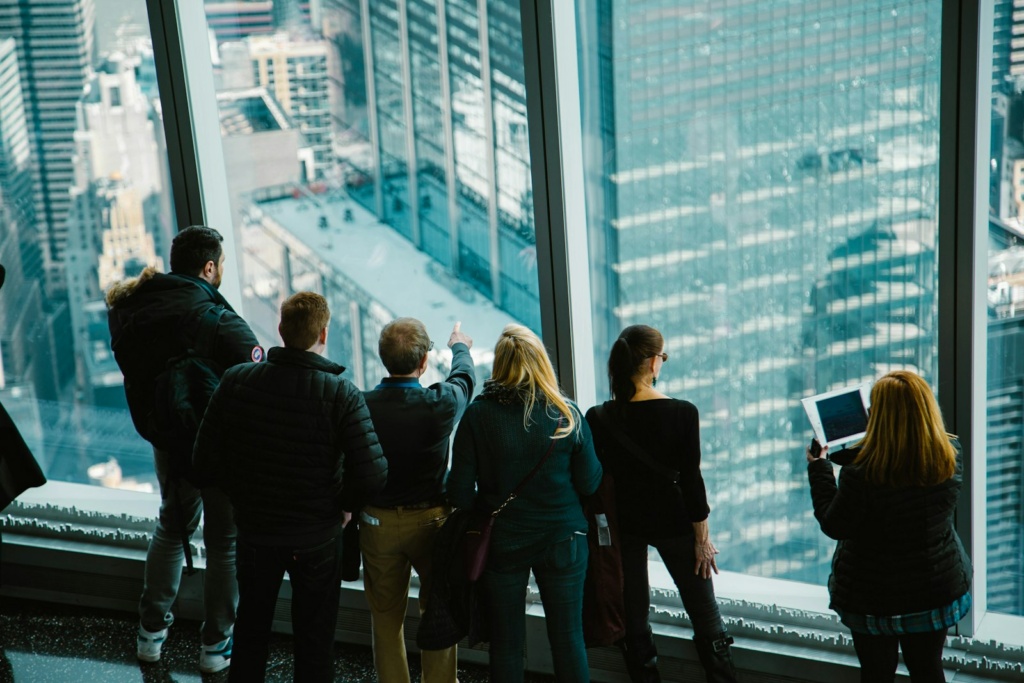Our daily lives are more digital than ever, and in this context, blockchain technology is gradually emerging as a transformative force across many sectors of activity. It brings particularly notable innovation with the development of non-fungible tokens, more commonly known by the acronym “NFT”. These digital assets are distinguished by their unique character and their ability to provide irrefutable proof of ownership and authenticity.
Far from being limited to the world of art and collections, NFTs are beginning to infiltrate many sectors, such as tourism, promising to reshape the interaction between destinations, brands, and travelers.
NFTs and Tourism: What for?
At their core, NFTs are unique cryptographic assets that exist on a blockchain, a kind of decentralized ledger that records all transactions. Unlike cryptocurrencies like Bitcoin, which are fungible and therefore interchangeable, each NFT is unique and cannot be replaced by another. This uniqueness gives NFTs a particular value, similar to digital artworks or collectible items whose provenance and transaction history can be verified by everyone (to learn more).
The adoption of NFTs in tourism suggests a paradigm shift. Previously, travel souvenirs were tangible, captured in photographs, trinkets, or experiences. NFTs reinvent this notion, allowing travelers to acquire unique digital memories, virtual experiences, or even proofs of attendance at events, all securely stored and transferable on the blockchain. This development does not fail to open up unprecedented opportunities to enrich the tourist experience.
In addition to their value as souvenirs, NFTs can also serve as tickets for attractions or events, offering enhanced security against fraud while adding a collectible and commemorative dimension. The benefits do not stop there. Indeed, the programmable nature of NFTs allows event organizers and tourism operators to link benefits, such as VIP access, discounts, or exclusive experiences, directly to the ownership of the NFT. In this way, they can foster customer loyalty and encourage attendance in an innovative and personalized manner.
The involvement of NFTs in tourism is not just a technological curiosity. It reflects a broader trend towards a more integrated digital economy, where blockchain and digital assets play an increasingly central role. The relationship between tourist sites, local businesses, and consumers is being redefined, paving the way for new forms of valorizing experiences, brands, and destinations. In short, the growing influence of NFTs in tourism heralds an era where technology disrupts and enriches the traditional contours of travel.

NFTs as a Tool for Enhancing the Tourist Experience
When we mention NFTs in the context of tourism, we refer to a plethora of practical applications that go beyond mere technological gadgets to anchor themselves in a genuine value proposition for both travelers and tourism service providers. The appeal of NFTs lies in their ability to crystallize moments, experiences, and privileges within a unique digital asset, thus transforming ephemeral memories into durable and exchangeable goods.
The innovation of NFTs in tourism particularly lies in the creation of tailor-made experiences that can be purchased, collected, and shared.
Some possible uses of NFTs in tourism
Imagine a traveler visiting a famous historical site and being offered an NFT as an exclusive digital souvenir. This NFT could include not only a digital artistic image of the site but also an immersive audio narration, revealing anecdotes or historical tales specific to the location of the traveler. These exclusive contents would enrich the visit, offering an additional layer of engagement with the site.
This is already possible since, as of October 2023, the Musée d’Orsay, offers to immortalize your memories and experiences with, for example, “the digital souvenirs of the Van Gogh exhibition at Auvers sur Oise”, the first NFTized experience to extend the visitor’s experience.
Furthermore, NFTs have the capacity to introduce a playful and interactive dimension to tourism. They can be used to create digital treasure hunts where participants explore different attractions in search of hidden NFTs. These “treasures” could then be used to unlock real-life benefits, such as priority access to certain attractions, discounts at local restaurants, or exclusive experiences reserved for the holders of the corresponding NFTs.
In the field of accommodation, hotels can deploy NFTs to offer upgrades, additional services, or personalized offers. For example, when booking a room, a customer could be awarded an NFT guaranteeing an upgrade, spa access, or a private cooking class with a local chef.
Moreover, these NFTs could be designed to increase in value over time, encouraging guests to return and enjoy greater rewards during their future stays. NFTs can also be used to authenticate and secure participation in exclusive events or excursions.

A tourist purchasing an NFT as a ticket for a cruise around isolated islands thus receives assurance against imitations and fraud, while keeping an indelible trace of this experience in their digital wallet. Once the event is over, the NFT retains its
value as a “collectible” or can be resold on the secondary market, potentially at a higher price if the event has gained in notoriety.
One of the most revolutionary aspects of NFTs in the tourism industry is their ability to forge virtual experiences. Travelers can now access virtual tours of inaccessible or distant sites, these tours being encapsulated in the form of NFTs. This allows for the immersive exploration of places around the world, without the physical or environmental constraints associated with travel. An NFT representing a virtual augmented reality tour of the lost city of Machu Picchu, for example, can offer the user an unprecedented interactive and educational experience, while preserving the site from the effects of overtourism.
Gamification is another fertile area for the use of NFTs in tourism. Mobile applications integrating game elements can encourage users to collect specific NFTs related to tourist sites or activities by performing certain actions or achieving predefined objectives. These NFTs can then be exchanged for real rewards, or serve as currency within digitized tourism ecosystems.
The applications of NFTs in tourism are limited only by the imagination of creators and the willingness of tourism actors to adopt new technologies. As visitors seek deeper and more personalized experiences, NFTs prove to be a powerful tool for meeting these desires, offering a fusion of the real and the virtual that makes each journey even more memorable.
Economic Benefits of NFTs for Tourist Sites and Local Actors
NFTs are not limited solely to the direct enhancement of the tourist experience. They also embody a tangible vector of economic growth for tourist sites and local businesses.
Their economic impact is exerted through several key levers, notably the creation of additional revenue, brand strengthening, monetization of exclusive experiences, and visitor loyalty. Monetization of Exclusive Experiences
NFTs offer an opportunity for the monetization of exclusive experiences through their sale as digital goods. For a tourist site, this could materialize through the creation of a limited series of NFTs encapsulating a virtual guided tour by a renowned historian, or an augmented reality visualization of what the place was at another time. These exclusive experiences, due to their rarity and added value, can be sold at a premium price. This results in a new source of revenue for the site, which traditionally only counted on entry tickets and shop sales.
Dynamic Pricing Strategies
The NFT market allows the use of dynamic pricing strategies. For example, an amusement park could issue NFTs giving access to express queues during peak periods. The limited number of these NFTs, combined with high demand, can lead to a price increase on the secondary market, thus generating additional revenue for the park while regulating the influx of visitors.

Loyalty Tools
Tourist sites and local businesses can use NFTs as a loyalty tool. By offering NFTs as rewards for repeat visits or spending in local shops, customers are encouraged to return, thus generating recurring revenue. These NFTs could include benefits such as discounts, access to private events, or unique experiences, making them particularly attractive.
Brand Strengthening and Storytelling
An often overlooked but crucially important aspect is the influence of NFTs on branding. A historical site that issues NFTs often incorporates elements of storytelling, which may include narratives, illustrations, music, or videos. This content helps to build the brand identity and establish an emotional connection with the audience. Thus, beyond the immediate transaction, NFTs contribute to the long-term image and story of the site or brand.
Strategic Partnerships
Strategic partnerships between tourist sites and artists or NFT creators can open up unexplored markets. For example, a museum could collaborate with a digital artist to create a collection of NFTs that blend art and history, sold or auctioned to attract an audience interested in both digital art and cultural heritage.
Augmented and Virtual Realities
The tourism sector can leverage NFTs to offer unique augmented or virtual realities, incorporating the past, present, and future of sites or events. This would not only attract a new segment of visitors but also create a dematerialized product that can be sold without geographical limits, thus surpassing the physical constraints of sites.
Sustainability and Conservation
NFTs can serve as support funds for conservation and sustainability. Limited editions of thematic NFTs can be specifically devoted to financing restoration projects or environmental preservation efforts. Consumers are increasingly aware of ethical and environmental issues, and NFTs offering a direct contribution to these causes can resonate well, while supporting the site’s conservation mission.
Fraud Prevention
In the tourism sector, counterfeiting and illegal resale of tickets represent a financial loss and a blow to the reputation of sites. NFTs, by their secure nature and traceability on the blockchain, can serve as authentic entry tickets, thus significantly reducing the risk of fraud.
Virtual Spaces and Metaverse
With the emergence of the metaverse, tourist sites can consider creating virtual spaces where users can interact with digital versions of the sites through avatars. NFT
s then become the currency of entry for these virtual experiences, creating a new revenue channel while reaching a global audience.
The potential of NFTs to generate added value for tourist sites and local businesses is undeniable. They allow for the diversification of revenue sources, enrich the visitor experience, strengthen the link between the brand and the consumer, and innovate in terms of marketing and loyalty. However, their implementation requires a strategic approach, an initial investment in technology and design, and a deep understanding of their target market.

The Empire State Building and Its NFT Initiative
The Empire State Building, a globally recognized icon of the New York skyline, has recently launched a pioneering initiative in tourism and technology: an ambassador program based on NFTs. By combining the timeless charm of one of the world’s most famous buildings with cutting-edge blockchain technology, the Empire State Building sets a significant milestone for the tourism industry. This program perfectly illustrates how tourist sites can embrace the digital era while enhancing and personalizing the visitor experience.
Designed in partnership with the Web3 loyalty platform Uptop and the digital wallet provider Magic, the ambassador program focuses on the Empire State Building’s observatory experience, offering visitors breathtaking 360-degree views of New York City. Following a $165 million renovation, the observatory has been transformed into an interactive museum with dedicated entrances for visitors and revamped observatories on the 86th and 102nd floors.
The program’s dynamics are simple: by purchasing tickets for these floors through the “ESB” website, visitors enroll in the loyalty program and receive an NFT, which acts not only as a digital souvenir but also as a key to access personalized benefits. The more a visitor returns to the observatory and engages with the program, the greater their chances of accessing higher levels and receiving personalized NFTs offering even more exclusive benefits.
The initiative presents several advantages.
First, it provides visitors with a tangible reason to return, thus fostering engagement and loyalty. Moreover, NFTs offer a notable marketing advantage. As digital collectibles, they attract not only technology enthusiasts but also those seeking unique pieces associated with an iconic location. Thus, they create a new angle of attraction for the monument, which can appeal beyond the traditional circle of tourists.
The Empire State Building’s NFT approach also highlights the potential of these technologies to generate new revenue sources for tourist sites. Each NFT sold represents direct income, not to mention the additional incentives they represent for on-site spending. These tokens can also be traded on secondary markets, offering speculative value that can encourage initial purchases.
Moreover, these NFTs promote interactivity with visitors. Thanks to blockchain, it is possible to track visitors’ interactions with the observatory, allowing for further personalization of the experience and offering targeted benefits based on individual preferences and behaviors. This data-oriented approach is crucial in a world where personalized experience is king.
Besides the direct benefits, the Empire State Building’s NFT program also serves as a springboard for strategic partnerships. The alliance between technology companies and a major tourist site sets a precedent for other potential collaborations. This could open the door to co-created brand experiences, special events, and even exclusive artistic collaborations that could be monetized as NFTs.
However, there are challenges to overcome to ensure the sustainability of such initiatives.
Issues related to cryptocurrency regulation, ease of use for novices, and environmental concerns associated with cryptocurrency mining are critical points. It is imperative that the Empire State Building and its partners address these issues to avoid deterring potential consumers or harming their reputation.
The Empire State Building’s ambassador program is undoubtedly a case study for tourist sites worldwide. It shows how the old and the new can unite to create an enriched value proposition. As the tourism sector seeks ways to bounce back after the challenges posed by the pandemic, NFTs emerge as an innovative solution to attract and retain visitors, while opening new revenue streams and strengthening destination branding.
This initiative could serve as a model for other sites looking to leverage NFTs to enhance their visitor experience. For example, museums, theme parks, and historical sites could create similar programs, offering exclusive benefits and personalized experiences. By capitalizing on the growing interest in NFTs and blockchain, tourist sites can advantageously position themselves in an increasingly competitive market while staying at the forefront of innovation and customer satisfaction.

NFTs and Ticketing for the Paris Olympic Games
Looking ahead to the upcoming Paris Olympic Games, the potential for integrating NFTs into ticketing systems unveils promising horizons for the evolution of the spectator experience and event management. The Olympic Games ecosystem provides fertile ground for adopting NFTs due to the diversity of audiences, the international scale, and the variety of sports disciplines. The use of NFTs for ticketing is not merely a matter of technological innovation; it involves restructuring the relationship between organizers, athletes, partners, and spectators.
In the context of the Paris Olympic Games, NFTs could be employed to create unique digital tickets, thereby offering spectators not only access to the event but also an enriched experience. These NFT tickets could incorporate personalized design elements, such as icons of Olympic sports, imagery of the host city, or interactive animations. They could also be programmed to include exclusive digital memorabilia, such as videos of highlight moments, photo albums, or even personalized messages from athletes.
Beyond the aesthetic aspect, NFTs could revolutionize the ticketing system through their traceability and security. The blockchain would enable tracking each ticket from its creation to its final use, significantly reducing the risks of fraud, counterfeiting, and scalping. Organizers could thus ensure that tickets remain in the hands of true fans and not speculative resellers. NFTs could also simplify the resale of tickets on the secondary market, ensuring ticket authenticity and potentially allowing organizers to capture a fraction of secondary sales, thereby injecting additional revenue into the event or supporting athletes.
The non-fungible nature of the NFT ticket would give each spectator a sense of exclusivity. Associating specific benefits, such as access to VIP areas, meetings with athletes, or behind-the-scenes glimpses, could add value to the tickets, transforming a simple entry into a genuine premium Olympic experience.
Selling tickets as NFTs could also be used to generate engagement with teams or athletes. Collections of NFTs linked to national teams or specific disciplines could be sold, granting tickets to corresponding events while financially supporting the involved athletes.
Collecting spectator data through NFTs opens the path to valuable behavioral analysis for organizers. By better understanding spectators’ preferences and journeys, it becomes possible to optimize future editions of the Games and tailor the commercial offerings around the event.
However, implementing this technology on a scale as large as the Olympic Games presents significant challenges. Education and accessibility remain major obstacles: the general public, not necessarily familiar with cryptocurrencies and blockchain, must be considered. Sales platforms and ticketing systems must be designed to be as intuitive as possible, minimizing friction during ticket purchases.
Regulation poses another significant challenge. With participants and spectators coming from all over the world, the Paris Olympic Games will need to navigate through the maze of different jurisdictions on cryptocurrencies and digital assets.
Furthermore, the environmental impact of blockchain and cryptocurrency mining remains a major concern, especially for an event aspiring to be sustainable and eco-friendly. Adopting greener blockchain technologies, using less energy-intensive consensus mechanisms like Proof of Stake (PoS), could be a solution to reconcile technological innovation with environmental responsibility.
The Paris Olympic Games have the opportunity to make history by adopting technology that redefines the exchange of value and user experience. The NFT-based ticketing system could not only optimize entry management but also enrich the Olympic experience and create a lasting digital legacy.

The Global Potential of NFTs in Tourism
The involvement of NFTs in the tourism industry promises a profound transformation in the interactions between tourist sites, local businesses, and travelers themselves.
At the heart of this revolution lies the ability of NFTs to create a new form of digital economy, where virtual assets become vectors for unprecedented experiences and added value. Let’s examine the large-scale implications of this integration, considering both innovative prospects and potential obstacles.
Globally, integrating NFTs into tourism could potentially redefine visitor engagement. With blockchain as the underlying technology, NFTs offer transaction authenticity and security that no previous system could guarantee. Thus, tourist sites can issue entry tickets, visit packages, or even virtual souvenirs as NFTs, providing consumers with undeniable proof of their visit or participation in an event. These digital assets prove to be powerful marketing tools, creating a lasting bond between the visitor and the visited place.
Loyalty initiatives also take on a new dimension with NFTs. For example, a museum could launch a limited series of NFTs allowing not only lifetime entry but also privileged access to special exhibitions or events. Tourists then become members of an exclusive community, strengthening their commitment to the brand or tourist site.
For local businesses, NFTs represent an opportunity to capture tourists’ interest by offering unique digital collectibles. A souvenir shop, for instance, could sell NFTs certifying the authenticity and local provenance of its products. Besides the physical item, the tourist acquires a rare and potentially appreciating digital element, thus generating a new form of revenue for merchants.
The rise of virtual and augmented experiences in tourism, already advancing through technologies like
virtual reality, is amplified by NFTs. They can serve as keys to unlock immersive online experiences, bridging the digital and physical worlds. As virtual reality becomes more immersive and accessible, tokenized virtual tour experiences could become a common extension of tourist sites, allowing visits to remote locations without leaving home. In this regard, the recent launch of Apple Vision could only enhance this trend.
However, there are significant hurdles to the large-scale implementation of NFTs in tourism.
The first of these challenges is public understanding and adoption. Despite their growing popularity, NFTs remain an abstract concept for many. This results in a need to educate and raise awareness among consumers to overcome technological barriers and facilitate the integration of NFTs into purchasing habits.
The second challenge is regulation. NFTs intersect with various regulatory domains: intellectual property, consumer protection, financial transaction security, among others. The legal framework around NFTs is still developing, and tourism businesses must be prepared to navigate a sea of potentially conflicting legislations.
The environmental impact is also a major concern. The production and maintenance of the blockchain can be energy-intensive, especially for systems based on Proof of Work (PoW) mechanisms. The tourism sector, already conscious of its ecological footprint, must therefore lean towards more sustainable, low-energy blockchain solutions.
Additionally, security and privacy issues are paramount. NFT transaction platforms must be impregnable to prevent fraud and ensure the protection of users’ personal data. This requires significant investments in cybersecurity and privacy protection technologies.
Despite these challenges, the future prospects for NFTs in tourism are bright. Enriched tourist experiences, value creation for sites and businesses, and the emergence of new forms of loyalty demonstrate the innovative potential of NFTs. Their applications in the sector could extend to traceability solutions for local products, certification of tour guides, or even digital preservation of cultural heritage. In the long term, the adoption of NFTs in tourism could lead to an ecosystem where travel is not only physical but also digital.
Augmented reality experiences enriched with tokenization would offer an additional layer of interaction with the world, transcending the traditional limits of exploration. With careful implementation, NFTs can become catalysts for innovation in tourism, opening unexplored avenues for traveler engagement and destination valorization.
Future Outlook and Long-term Impact of NFTs on Tourism
Non-Fungible Tokens (NFTs) are far more than a passing trend in the digital world; they represent a substantial evolution in how we perceive ownership, authenticity, and the consumer experience. In the tourism sector, this emerging technology heralds a revolution that could not only transform interactions between tourists and destinations but also reinvent the very concept of travel.
The gradual adoption of NFTs envisions a future where the complete digitization of travel experiences becomes the norm. Tickets and reservations could turn into unique digital assets, thereby enabling a deep customization of offers. Tourists might be offered tailored itineraries, exclusive experiences, and digitized memories, all encapsulated in a non-fungible token.
In such an environment, data collected through NFT transactions would offer tourism stakeholders valuable insights into visitors’ preferences and behaviors. Loyalty programs would evolve into ecosystems where loyalty points are embodied in NFTs, capable of being exchanged, sold, or kept, turning every experience into a potential investment. The uniqueness of each NFT would create a collection dimension for travel, encouraging the discovery of new destinations to expand this personal collection of unique moments.
Moreover, the traceability and authenticity guaranteed by blockchain could lead to quality certifications for local products and services, enhancing consumer trust and valuing regional craftsmanship. The tourism sector could thus become a guarantor of authenticity and contribute to the preservation of local cultures and traditions through NFTs.
The convergence of virtual reality (VR) and augmented reality (AR) technologies with NFTs represents another promising horizon. Historical sites and museums could offer virtual replicas of their spaces, accessible via NFTs. These virtual tours would not just replicate reality but transcend it, enabling experiences inaccessible in the physical world, such as viewing sites in their past state or interactively manipulating artifacts.
Despite these opportunities, significant challenges remain. Establishing a robust, privacy-respecting, and ecologically viable infrastructure is imperative. The energy consumption of blockchains using the Proof of Work (PoW) consensus mechanism must give way to greener alternatives like Proof of Stake (PoS). Regulation, constantly catching up with technological innovations, must adapt quickly to effectively frame the issuance, sale, and resale of NFTs while protecting consumer rights.
Despite these challenges, the future of tourism shaped by NFTs looks bright. They could redefine notions of belonging and experience, turning each journey into a digital artwork, an exclusive chapter in each individual’s personal story. In the long term, NFTs could thus become the symbol of a new era of tourism, where value is attributed not only to physical experiences but also to their digital footprint, perpetually inscribed in the blockchain’s marble.



